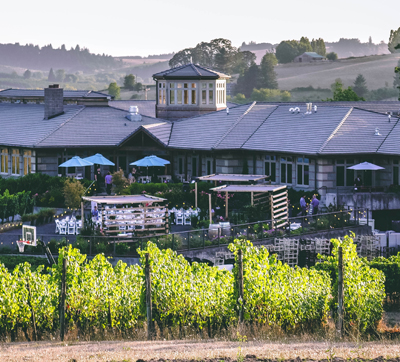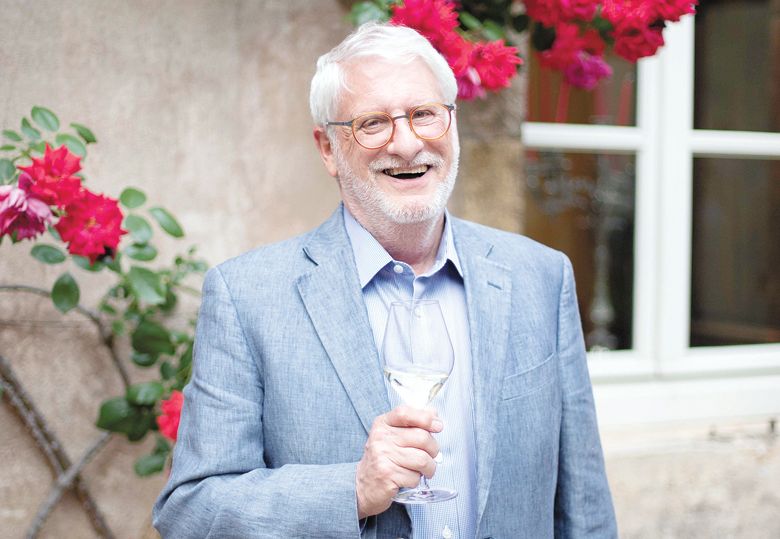Q&A: David Adelsheim
Oregon winemaker, leader, advocate
In 1971, after meeting several of the pioneering winemakers, David Adelsheim and his former wife, Ginny, purchased 19 acres in the Chehalem Mountains. They converted part of their basement for use as the first winery in 1978, becoming one of 10 families making wine in the area prior to 1980. Over the course of Adelsheim Vineyard’s decades-long history, David has worn many hats — vineyard manager, winemaker, sales and marketing director, bookkeeper and president. His early winemaking experience included work at The Eyrie Vineyards and at the experimental winery of the Lycée Viticole in Beaune, France. From 1972 to 1977, he wrote and pushed the OLCC to approve the strictest labeling regulations in America. David also helped write AVA petitions for the Willamette Valley, Umpqua Valley and Chehalem Mountains. He’s been instrumental in helping the Oregon industry procure important clones and varieties from France and Germany, not to mention the founding of Oregon Pinot Camp in 2000, establishing the Oregon Wine Board in 2005 and rebuilding the Willamette Valley Wineries Association in 2007. In 2017, he sold his ownership of Adelsheim Vineyard to his partners of 25 years, Lynn and Jack Loacker.

What is your current role at Adelsheim Vineyards?
DA: Yes, indeed. When Adelsheim hired a CEO in April 2017, my first role was to help him get up to speed in that job. As he spread his wings, that allowed me to refocus on a few things I’d always done – export sales and supporting our distributor salespeople. Both required travel, which I mostly enjoy. Selling wine outside the U.S. requires cultural and language sensitivity. It also requires tremendous focus on education. You can’t tell people just about Adelsheim; you have to give customers a sense of the whole Willamette Valley wine industry. And frankly, you usually need to start with information on Oregon wine generally and, in most places, an introduction to American wine. With most of our importers, we are their only Oregon wine and sometimes their only American wine. The stories and facts needed to sell our wine become very different from what is needed in the States. But even when selling wine to our distributors around the country, with so many brands of Willamette Valley wine available, one of the inherent advantages we have is our heritage. And I have certain advantages in that department.
The other major role I took on had to do with advocacy and public policy. Our winery has always played a role in such matters, so it was a natural direction for me.
How are you involved in the greater wine industry?
DA: I’m still on the Board of the Chehalem Mountains Winegrowers and starting work that will further define the wines of that AVA and increase understanding about the relationships between the sectors of the Chehalem Mountains and the style of wines possible in each.
With my involvement in the export of Adelsheim wine, I’ve worked closely with the Oregon Wine Board on the 2017 major redesign of the Oregon stand at ProWein in Düsseldorf (the world’s largest wine trade fair.) Each year, I’ve been asked to present seminars there (in English and German) on WV Pinot noir. And I helped with the first Mexico City tasting in January 2020, including with the seminar presented on Oregon wines.
In the summer of 2017, Ken Wright convened a meeting to discuss the threats to the reputation of the Willamette Valley and what could be done. That, of course, led to the labeling proposals from the Willamette Valley Wineries Association and the knock-down, drag-out 2019 legislative session. And a lot of bruises. The fight for preserving our reputation is not over.
What do you miss most about the day-to-day operations of running a winery/vineyard?
DA: Now that’s an existential question! If you’re the person in charge of running a company, your job is really to help your employees to do their jobs superbly. You are an intrinsic part of every department and every major decision. Your life is overfilled with big and small issues and your to-do list continually grows. Your calendar is filled every day and almost every hour with meetings, many of them requested by others. I loved that life and did a pretty good job under all that pressure. When it was all suddenly handed off to someone else, at first, I missed that life. I had trouble starting a day without every hour being predetermined.
But now, starting my third year of having no employees and very few meetings, I am really enjoying being able to observe and investigate bigger, longer term issues: the historical arc of the WV wine industry; the role for wines of place in the United States without Baby Boomers; and the things our industry must do to prevent its suffocation under its own success.
What do you believe is the biggest challenge currently facing the Oregon wine industry?
DA: Obviously, THE biggest is climate change. The reputation of Willamette Valley wines was built on our cooler, unique climate. It’s why a light goes on in the brain of wine professionals who try WV wine for the first time. This isn’t what was expected from a New World wine region. It’s more like a wine from northern Europe. That juxtaposition can only happen in a place with a cooler climate — at least during the final ripening period. In Oregon, we can mitigate climate change for a while by picking earlier, allowing higher yields, and by planting vineyards at higher elevations and on northerly slopes. But we can’t mitigate against change forever. Pinot noir IS the Willamette Valley. When our climate is no longer perfect for Pinot, we will, eventually, have to start over. Is that even possible?
The second huge challenge is the “colonization” of Oregon – and particularly of the Willamette Valley — by California. Currently, around a quarter of Oregon grapes go to California to be made into wine. This is often done at low overhead, large capacity facilities with low-cost Oregon grapes being turned into low-priced wines. This should be good for consumers, right? Well, not if the consumer wants an Oregon wine that tastes like what s/he has come to love. The California version doesn’t need to follow Oregon’s strict labeling regulations so a Pinot noir can be 25% Syrah … or worse. This is way too complex an issue to get bogged down in details here. But, ultimately, the Willamette Valley wine industry was built on collaboration. Growers, winemakers, salespeople working together, not brand by brand, to raise the tide for all brands. The winemakers and salespeople at the California wineries do not collaborate with the industry people in Oregon. They can afford to work on their own and show us how to do it “correctly!” (Obviously, this is not meant as a diatribe against every California winery making wine from Oregon grapes. Those, who make their wine in Oregon, for example, are often very collaborative and seek to produce wines in the traditional Willamette Valley style.)
And then there’s land use. What kind of wine tourist wants to visit a region where the most famous wineries are on crowded (and potentially hazardous) country roads; where the tasting room view is of other tasting rooms; and tastings are either by appointment only or are so crowded that you have to wait in line just to try a wine? (I know it’s hard to imagine “crowded” tasting rooms and roads right at this pandemic moment, but this could be again in our not-so-distant future.) And what do our neighbors, who want to farm and have peace and quiet, think? Will they start trying to stop every winery project proposed to the county commission, just on principle? Look at life in Sonoma, Napa and Santa Barbara counties. Is that the future we want?
Finally, of course, there’s the short-term challenge of recovering from the COVID-19 economic crisis.
Name the latest Oregon wine(s) to really impress your palate?
DA: When we were in Burgundy last year, on a couple occasions, we tried Oregon wines side-by-side with some pretty wonderful Burgundies. And I was left with the nagging impression that many of the Willamette Valley Pinots were riper than the Burgundies. And riper than I remember our wines being. I came to suspect that we as an industry had developed a “house palate.” That is, we’ve tasted riper and riper WV Pinots for so many years that we have forgotten what cool-climate Pinot noir can taste like. This is more than just a question of consumer preference. Riper wines tend to hide the specific references to place and to vintage under their overwhelming richness and concentration.
Thus, and to your actual question, the wines that are impressing me now are coming from the WV winemakers, who are choosing to pick earlier. But it’s not simply a matter of picking earlier. It demands clarity as to what constitutes “ripe enough” and then extremely accurate decision-making on when to pick each block. Earlier picking is much more difficult and risky. Underripeness is as problematic as overripeness. So, who is picking earlier? Josh Bergström, Ken Pahlow at Walter Scott, Thomas Savre at Lingua Franca and Shane Moore at Gran Moraine. Jason Lett at Eyrie has continued that tradition there. And I was blown away last fall by a 2016 from Maggie Harrison (Antica Terra) that was much more reserved and expressive than what I remember from her previously. And, obviously, at our winery, Gina Hennen has modified the direction, as well. Already, her first Chardonnays show the traits of earlier picking and the next Pinots will, too.
Any exciting new projects (wine or personal) on the horizon?
DA: We will have a new CEO – Rob Alstrin from Argyle – starting May 18 at Adelsheim. He and I have a long history of working together on many projects. So, I’m very excited to help him position the winery for an even greater future.
We have a new importer in Russia. Eugenia and I are hoping to visit and help its staff learn to sell Oregon wine.
And, I’m doing a bit of writing.











